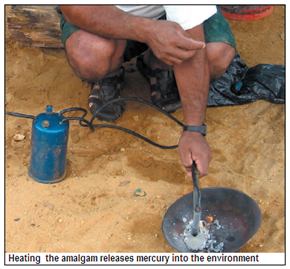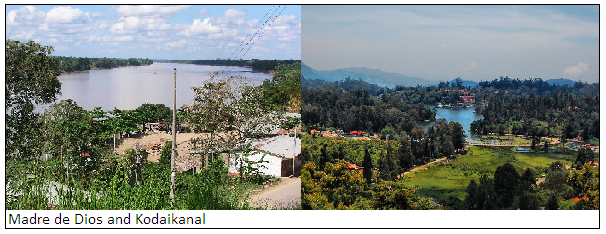The government of Peru has declared a 60-day period of emergency to deal with mercury pollution, says, says S.Ananthanarayanan.
The crisis has arisen as a result of unregulated mining along theMadre de Dios River, which flows through Peru, in South America. The river is a major part of the Amazon watershed and the sand of the river bed is rich in deposits of gold. While limited panning for gold has been traditional, the rise in world gold prices in recent years, and also the recession, has created a boom in the activity.
The process used is to pan the river water, so that the heavier, gold-bearing sand particles separate. Gold is then extracted using the element, mercury, which readily forms an alloy, called an amalgam, with gold. The gold is recovered from the amalgam by heating, which vaporizes the mercury and leaves metallic gold. with In properly organised processing mercury, the vapours are captured and condensed, to partly recover the mercury. In unregulated, small scale operations, however, the mercury just escapes into the surrounding air. There are now safer methods to extract gold, but mercury is still the way out for the illegal gold mining that has arisen in Peru.

Metallic mercury, which is a liquid at usual temperatures, is a heavy (it is denser than lead), silvery liquid that flows easily and does not wet glass, but forms droplets, like an oil. It is a fairly good conductor of electricity and this has made it useful in creating good electrical contacts. And as it expands when heated, can flow through a narrow tube and is shiny and visible, it finds application in thermometers. Mercury is also used in fluorescent lamps and in CFL bulbs. But like most heavy metals, mercury compounds are poisonous if ingested. The metal itself is inert and it does not directly cause serious harm, but it needs to be carefully removed if it is spilt, as it can be absorbed by the skin or as vapour. In the form of soluble salts, and more so as organic compounds, it leads to severe disease, particularly brain or liver damage.
Mercury gets released into the environment naturally by volcanic action and also by manmade mechanisms. The manmade sources are mainly burning of coal, gold mining using mercury amalgam, the manufacture of cement, iron and steel and chemicals, incineration of garbage and by careless disposal of waste in manufacture of batteries, thermometers, etc.
While mercury in the atmosphere is inhaled by people or animals or taken up by plants, the most serious damage is caused when mercury enters waterways, where certain bacteria convert metallic mercury into the organic and highly toxic form, methyl mercury. Bacteria are perhaps the only living organisms that can take metals and convert them from insoluble to soluble forms or other chemical forms. Certain bacteria, for instance, can turn insoluble iron content of water into a soluble form when oxygen is scarce and back to insoluble sludge when the water emerges into the air. While this is a case of salts of mercury being changed from one form to another, the change to an organic form enables mercury to be taken up by plants and fish. And where fish is an important part of human diet, as in along the Madre de Dios River, this forms a channel by which human mercury accumulates and levels steadily build up.
It has been estimated that 40-50 tonnes of mercury are used every year in gold mining, much of which ends up in the waterways of the Madre de Dios region, which bacteria convert to methyl mercury. A team from the University of North Carolina at Durham has tested nearly 3,000 people in the region and has found that levels of mercury in hair samples of 40% of them were above the maximum prescribed by the World Health Organisation. Studies have also shown high mercury levels in larger fish, which prey on smaller fish and close correlation between high mercury exposure and fish consumption has been proved.
The Peru government has used the Duke University study to decide which of the riverside communities have priority for emergency aid. The relief includes supply of food, which has canned ocean fish, to replace their usual high risk diet and also multivitamins to combat anemia. The aid is to roughly 15,000 of the 48,000 people affected. The emergency declared is for 60 days only because the government is due to change. Relief action, however, is sure to continue under the new administration.

Closer home, Kodaikanal, a hill station in Tamil Nadu, is dealing with a case of severe mercury poisoning of the environment since the year 1982. This is the year that a thermometer factory owned by the cosmetics maker Chesebrough-Ponds and later acquired by Hindustan Lever Ltd, was moved to India following objections in the USA to the pollution that the plant caused. When factory workers complained of kidney disease and there was an accidental discovery of mercury in samples of plants purchased by a laboratory in Hyderabad, it came to light that mercury levels were elevated in Kodaikanal. Further probe revealed disposal of thermometer production waste in the nearby forest and the factory finally admitted to having been responsible. The factory was then shut down and remediation of the area is continuing, with the mercury level in the air, even after the closure of the factory, being found to be 1.32 micrograms per cubic meter — about thousand times higher than what is found in uncontaminated areas.
The genes involved
How methyl mercury, the organic form of mercury, arises from natural processes in the environment was a mystery since decades. Scientists at the Oak Ridge National Laboratory have now discovered the genetic basis for the process. The cluster of two genes which have been identified is found in all bacteria that have the capacity to form the compound. The capacity disappears if the genes are removed and reappears when they are restored.
“This newly gained knowledge will allow scientists to study proteins responsible for the conversion process and learn what controls the activity,” said Liyuan Liang, co-author of the paper in the journal, Science, where the discovery was reported, in Feb 2013. The discovery is important indeed as it may lead to methods of limiting levels of methyl mercury in the environment.
The way mercury affects the brain is by blocking the action of selenium dependent enzymes that maintain antioxidant substances. As the brain is a heavy consumer of oxygen, there is much reactive oxygen around brain cells and reduced levels of selenoenzymes renders brain cells vulnerable to damage. Mercury atoms also denature amino acids necessary for forming protein and disrupt absorption of key nutrients.
The organic compound, dimethyl mercury , which some bacteria can produce, is so poisonous that even a thousandth of a cc, spilled on the skin, or even on a latex glove, through which it is able to pass, can lead to death in a few months after exposure.------------------------------------------------------------------------------------------